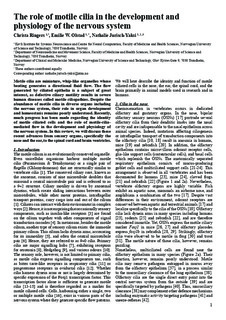| dc.contributor.author | Jurisch-Yaksi, Nathalie | |
| dc.contributor.author | Ringers, Christa | |
| dc.contributor.author | Olstad, Emile Willoch | |
| dc.date.accessioned | 2020-02-20T13:16:39Z | |
| dc.date.available | 2020-02-20T13:16:39Z | |
| dc.date.created | 2019-10-02T11:32:39Z | |
| dc.date.issued | 2019 | |
| dc.identifier.issn | 0962-8436 | |
| dc.identifier.uri | http://hdl.handle.net/11250/2642982 | |
| dc.description.abstract | Motile cilia are miniature, whip-like organelles whose beating generates a directional fluid flow. The flow generated by ciliated epithelia is a subject of great interest, as defective ciliary motility results in severe human diseases called motile ciliopathies. Despite the abundance of motile cilia in diverse organs including the nervous system, their role in organ development and homeostasis remains poorly understood. Recently, much progress has been made regarding the identity of motile ciliated cells and the role of motile-cilia-mediated flow in the development and physiology of the nervous system. In this review, we will discuss these recent advances from sensory organs, specifically the nose and the ear, to the spinal cord and brain ventricles. | nb_NO |
| dc.language.iso | eng | nb_NO |
| dc.publisher | The Royal Society | nb_NO |
| dc.title | The role of motile cilia in the development and physiology of the nervous system | nb_NO |
| dc.type | Journal article | nb_NO |
| dc.type | Peer reviewed | nb_NO |
| dc.description.version | acceptedVersion | nb_NO |
| dc.source.journal | Philosophical Transactions of the Royal Society of London. Biological Sciences | nb_NO |
| dc.identifier.doi | 10.1098/rstb.2019.0156 | |
| dc.identifier.cristin | 1732942 | |
| dc.description.localcode | © 2019. This is the authors' accepted and refereed manuscript to the article. The final authenticated version is available online at: https://doi.org/10.1098/rstb.2019.0156 | nb_NO |
| cristin.unitcode | 194,65,60,0 | |
| cristin.unitname | Kavliinstitutt for nevrovitenskap | |
| cristin.ispublished | false | |
| cristin.fulltext | postprint | |
| cristin.qualitycode | 2 | |
